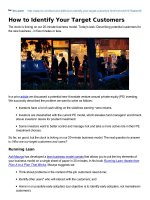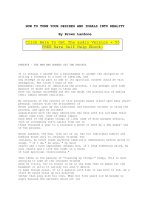Breaking the Time Barrier How to Unlock Your True Earning Potential
Bạn đang xem bản rút gọn của tài liệu. Xem và tải ngay bản đầy đủ của tài liệu tại đây (1.54 MB, 70 trang )
Praise for Breaking
the Time Barrier
“It’s the eternal struggle of the freelance worker: how do you price
your work in a way that’s fair to both you and the client? Nothing
less than your career success and personal happiness hinges
on this question. Spend an hour with this book, and you’ll come
away with a whole new way of looking at your value and your
relationship with your clients.”
—Daniel H. Pink, best-selling author of Drive, A Whole New
Mind and Free Agent Nation
“Spectacularly simple, remarkably true, for every small business
owner who’s determined to grow, Breaking the Time Barrier will
work for you!”
—MicHael e. Gerber, best-selling author of The E-Myth, and
inventor of The Dreaming Room for entrepreneurs
“People constantly ask me ‘How can I get a 4-hour workweek with
a service business?’ This story is the short answer.”
—TiM Ferriss, author of the #1 bestseller, The 4-Hour
Workweek
“This book unlocks the truth about how to build an insanely
protable business.”
—JoHn JanTscH, best-selling author of Duct Tape Marketing
“I urge my friends in public accounting to rst read the book and
then make sure every one of your small business clients does too.
It could prove to be the most important 30 minutes you invest this
year!”
—GreGory l. laFolleTTe, CPA.CITP CGMA
“Breaking The Time Barrier is a must read for every business
owner who’s ever struggled with putting a price tag on their
services. If only it would have been around when I started my
design studio.”
—Tina roTH eisenberG, founder of CreativeMornings,
swiss-miss.com
“In order to understand the dierence between time and
value, just read Breaking the Time Barrier. In about an hour,
Mike McDerment will get you up to speed on the fundamental
dierence between churning billable hours and delivering
value to your clients.”
—saM Glover, editor-in-chief of the law practice blog,
Lawyerist.com
Breaking the
Time Barrier
How to Unlock Your True
Earning Potential
TORONTO
Copyright © 2013 FreshBooks
Mike McDerment and Donald Cowper
A word or two
before we begin
In January 2003, I was running a small design rm
when I nally snapped. I was using Microsoft Word to
bill my clients when I accidently saved over an invoice.
The frustration of billing my clients overwhelmed me,
and so did the thought of using accounting software—
so I built my own solution.
Building my own product company quickly became a
passion, but passion projects don’t pay…at least not
on day one. To keep the lights on I moved into my
parents’ basement for 3.5 years to save money and
I completely revamped how I ran my design rm to
the point where I worked 19 days in one year and
generated over $200,000 to fund my side project.
How did I do that? This book will show you—and help
you do it too.
Thinking back, my ability to work so little and
produce so much income had a lot to do with how I
priced and positioned my services, something most
small business owners struggle with. So I sat down
with Donald Cowper—a best-selling author who
joined FreshBooks as our small business writer last
year—to try and capture the essence of things. The
result is this book—a business fable designed to share
the lessons I learned the hard way, so you don’t have
to.
This book will take you one hour to read, and you can
read it for free. But a free book about pricing, that’s
ironic, no? Yes. So here’s the twist: I hope that once
you have read this book you will nd it so valuable you
will WANT to pay for it to recognize its value. Should
you feel that way, please do two things. First, share
it with others so they can benet too. Second, go to
FreshBooks.com/BreakingtheTimeBarrier where you
can pay what you believe this book is worth to you
and your business…it could be one dollar, could be
$5000—you decide.
With that, enjoy.
—Mike
Mike McDerment
Co-founder & CEO
FreshBooks
About FreshBooks
FreshBooks is a simple-to-use, cloud-based
accounting solution designed exclusively for small
business owners—the kind of owners who are
passionate about what they do and may not fully
understand a balance sheet (or even know what one
is), and shouldn’t be ashamed of that. Since launching
in May 2004 from Mike’s parents’ basement,
FreshBooks has helped more than 5 million people
send and receive, print and pay invoices.
At the time of writing, only Intuit—makers of
QuickBooks—have more online paying customers in
America than FreshBooks, making FreshBooks the
#1 cloud accounting solution designed exclusively for
small business owners.
The FreshBooks vision is a world where entrepreneurs
successfully run their businesses without having to
learn accounting. If this sounds good to you, go to
FreshBooks.com and try it for free.
8
False Start
teve stepped out of his boss’s oce, stunned.
The company couldn’t meet its payroll and
needed to cut half its sta. Steve was one of
the unlucky ones. It was the second time he’d been
laid o because his employer went belly-up. And it
would be the last, he thought as he marched out of the
building. He was going to start his own design rm,
take charge of his own destiny.
Three weeks later he was sitting in front of someone
who wanted him to work his design magic on her
9
website. Then she asked a question he wasn’t fully
prepared to answer—“How much is this going to cost
me?”
That night, Steve jumped on his computer and began
searching for what other freelance web designers
charged. The results weren’t very helpful. Some
designers charged $10/hr, some over $200/hr, and
the rest charged anything in between. He wasn’t sure
where to peg himself. Then he remembered that his
old college buddy John had gone out on his own as a
designer.
Over the phone, John suggested that Steve gure out
his rates using a tried-and-true pricing formula—an
approach that is known in the accounting world as
“cost-plus.” With the help of an online rate calculator,
Steve plugged in his costs—the various business
expenses he expected to have as well as his personal
life expenses. After he put in how many hours he
would be able to work over the year, the calculator
spat out a breakeven rate of $50/hr. To generate a
20% prot—the “plus” element in “cost-plus”—he
would have to charge $60/hr. If he worked steadily,
his annual income—after business expenses, taxes
and government plans—would be around $50,000.
10
It wasn’t the six-gure income he hoped to make one
day, but he felt it was fair considering he was just
starting out.
Steve won that client, and a few others over the
ensuing weeks. He was busy, but found himself
struggling with a few problems.
For one, he was almost always competing for the
business, sometimes against cut-rate designers or
services that oered inexpensive, do-it-yourself
website solutions. He would try to explain why he was
the better choice, but in the end, he felt that if he stuck
to his rates, he’d lose out. And at this early stage, he
badly needed to build a clientele. So he would often
oer discounts, sometimes below his breakeven rate.
He wasn’t happy about it, but it seemed to be the only
way he’d stand a chance to get the business.
For another, Steve would also try to beat out the
competition by quoting fees based on conservative
estimates. It worked a lot of the time, but it usually
meant he had to put in more time to nish his
projects. Plus, a lot of his clients tended to grind him
down, insisting on extras here and there. The result—
11
he was making signicantly less per hour than the rate
he billed.
A few months after going solo, he was run ragged and
having trouble paying his bills. A conversation one
night with John helped him through a particularly low
time.
“Everyone goes through these growing pains,” John
said. “When you’re new, you do what you gotta do to
win the business and survive. It’s a matter of paying
dues. You hustle, gain experience and build up your
skill set until you establish a clientele of higher-quality
clients. Don’t worry, things will improve.”
On the cusp
Steve took John’s words to heart and muscled on. His
perseverance looked like it would soon pay o after
a friend introduced him to a start-up with a health
product. Steve loved the people at the start-up, and
their product too. They wanted a killer website with
an e-commerce function. It was going to be a large
project that would keep Steve busy for a few months,
with ongoing servicing after that. As an added
bonus, the start-up was well capitalized and so Steve
12
proposed a fee based on his protable hourly rate,
which they didn’t blink at.
Steve, who felt like he was on the cusp of success,
threw himself into the project. The start-up team
loved his work, particularly his great ideas around
how to design the site as a marketing engine, not just
a storefront. Steve’s ideas worked wonders. Soon after
the site went live, the company began selling product
at an accelerating rate, hitting their aggressive
revenue targets on time. Everyone at the company was
going to get rich. Steve was thrilled that he had been
instrumental in the start-up’s wild success. But given
the kind of impact he’d made, a part of him wondered
if he’d charged for his services properly. After all, it
was his ideas, not just his work, that had made the
dierence.
The next time Steve spoke with John, he explained
what had happened with the start-up, and asked John
if he ever felt underpaid in situations like that.
“Sure, I get that feeling sometimes,” John said. “I did
this amazing redesign for a client that totally turned
around their business. Considering the impact it had
13
on their revenue compared to what I charged, they got
an amazing deal. But what else can you do?”
“I don’t know. That’s why I’m calling you.”
“Well, all you can do,” John said, “is try to increase
your rates so it gets a little fairer. In this case, I’d
negotiate a higher rate for your ongoing service for the
start-up.”
Steve did quote a higher rate for the maintenance
work, which the team agreed to, but the ongoing
service amounted to only a couple hours a week. So
Steve had to scramble again for new business. He
was determined, however, to charge a higher hourly
rate to all new clients. Unfortunately, many of his
prospects were referrals from clients he had oered
discounts to, who expected similar rates. Because he
was desperate for billable hours, he took on the low-
paying business.
With a six-gure income looking like a pipe dream,
Steve put in another call to his buddy John, hoping for
some new insights. Instead he discovered that John
had just taken a full-time position. Steve was oored.
After probing, he learned that John had been secretly
struggling. Work wasn’t always steady and bills had
14
been piling up. With a new kid on the way, John had
decided he needed the security of a steady paycheck.
Darkness
After hanging up the phone, Steve sat down on his
living room couch, put his head in his hands and
closed his eyes. All he could see was darkness. He
began to wonder if he should pull the chute like John.
It was a thought that gave him some relief. After all,
the past few months hadn’t been much fun. As he sat
there contemplating the death of his young business,
he recalled the afternoon his former boss called
him into his oce and told him he had just received
his last paycheck. It was a painful day, but one that
taught him a lesson—there was no more security in
a full-time job than in running your own business.
He hoped things would work out for John, but Steve
wasn’t going to put all his energy into nding a job,
only to get laid o a third time.
Steve opened his eyes and looked around his living
room. He made a promise to himself right then—that
he was not going to give up. And right after that, he
made another promise—that he was going to nd a
way to do more than just scrape by. The world was full
15
of successful business owners and somehow he was
going to become one of them. Exactly how, he didn’t
know yet. But he went to sleep that night determined
to nd out.
The next morning it hit Steve that seeking John’s
advice had probably not been the wisest move. John
had been handy, but that didn’t make him the right
teacher. After spending a few hours sifting through
his list of contacts, Steve found that he had a mutual
connection with Karen, one of the most successful
designers in his city. Later that afternoon he spoke
with Karen over the phone. After briey sharing his
story, he explained that he was reaching out to her
because she was an inspiration and he needed some
of that now. She said she’d be happy to talk with him
and they agreed to meet at Karen’s favorite café that
Friday.
16
A Whole New Way
of Thinking
n Friday Steve stepped into Karen’s café,
a cozy spot with leather chairs and shelves
lined with old books. He looked around,
taking in the aroma of fresh coee, then made his way
to a back table, where Karen was waiting for him.
After Karen greeted him warmly he settled into his chair,
thanking her for meeting with him.
“I’m happy to help,” she said before a server came and
took their order. Then Karen invited Steve to sketch
17
out his solopreneur journey, which he did over the
clatter of coee cups that surrounded them.
When Steve was done she gave him a one-word
verdict: “Pricing.”
“Pricing?” he asked.
She nodded as their coees arrived. “Well…pricing
and positioning. From what you’ve told me, it sounds
like the way you think about pricing is holding you
back.”
“In what way?”
“If someone wanted to know what exactly you sell to
your clients, what would you tell them?”
“My services. Web design.”
“How do you charge for your services?”
“I charge them a fee based on my hourly rate.”
“Then aren’t you really selling hours?” Karen asked.
“But I use those hours to design websites.”
“Do those websites have any positive impact on your
clients?”
18
“Sure,” Steve said.
“Do you think it would make more sense to charge a
xed fee that represents the value of the impact your
websites have on your clients?”
“Well, I do mostly charge xed fees—”
“But those fees are based on a multiple of your hours,
right?”
“Right,” he said.
“I’m talking about xed fees based on value, not time.”
“I guess I’m not sure what you mean by value.”
“The value of what I do,” Karen said, “is based on the
impact I can have on my client’s business. Impact
is how they value my services. So I look at pricing
from their point of view. They don’t hire me to design
a website for the sake of designing a website. They
hire me to design a website that’s going to help them
grow their business. I nd when I look at it like that—
from their perspective—it’s clear I’m not selling time.
Instead, I’m selling a solution that is going to make
an impact for my client and achieve some business
objective.”
19
“So, how do you set
your prices then?”
“Let me give you an
example. A couple of
months ago I sat down
with a client to talk
about their website. I
asked them to tell me why they thought they needed
a website. When we drilled down into their reasons,
they said they believed a website could generate
an additional $100,000 of prot annually for their
business. So I asked them to make an investment of
$20,000 in the website. Based on your hourly pricing
model, you’d probably charge in the area of $2,000 to
$2,500.”
“Did they agree to your price?”
“Yes. Wouldn’t you invest $20,000 to generate
$100,000?”
Steve agreed and he was excited about what Karen
was telling him, but lots of questions were ooding his
brain. “I get your math,” he said, “but doesn’t it come
down to time in the end anyway? I mean, you spend
a certain amount of time on the project. You could
“The value of what I do
is based on the impact I
can have on my client’s
business.”
20
theoretically work out your hourly rate and so could
your client. You’re probably eectively charging $400
an hour, or something like that. What if your client
thinks that’s too high?”
“Your math may be right, but I’m not a collection of
hours,” Karen said. “I’m the accumulation of all my
skills and talents. I’m wisdom and creativity. I’ve
stopped seeing myself as a punch card. My clients
don’t see me that way either. Yes, sometimes, I’ve
had to change my client’s mind-set. But it starts with
me, rst, just as it starts with you. You have to forget
selling time. The best thing you could do for yourself
is to get the concept of time out of your head.”
“Don’t I need an hourly
rate for some stu?
Everyone I know has
one.”
“You know me now,
and I don’t have an hourly
rate.”
“So I should never
charge by the hour?”
“I’m the accumulation
of all my skills and
talents. I’m wisdom
and creativity.”
21
“To be honest, when I started out I charged an hourly
rate and I think hourly rates make sense for someone
just starting out, someone with little experience and
limited skill. But over time I established myself and
my credibility, which led to great references. When
that happens, you begin to outgrow the cost-plus
pricing model of charging by the hour. So if you stay
with that pricing model, you’ll nd it very limiting.
“For example,” Karen continued, “since there are only
so many hours in a year, it puts a cap on how much
revenue you can collect in a year, and it means that
the only way to make more money is to work more
hours. These are limits…and the truth is, they are false
limitations that lead to bad behaviors, like burning
yourself out by working around the clock in an eort
to earn more.”
“That’s me,” Steve said.
“Me too, when I rst went out on my own, until I
learned that a value-based approach to pricing your
services is a powerful way to break through the time
barrier and avoid the bad behaviors. But like a lot
of people, I didn’t start from scratch, and neither
did you. You started your business after many years
22
of design experience. You already had the ability to
create value for your clients. And now, after being in
business for a while, you’ve got references you can
build on. You’ve also had the chance to see the impact
your projects have had. I’m sure it’s far greater than
you expected. Think of the value you created for that
health start-up. That’s an impressive story that you
can use to move away from charging based on time to
charging based on value.”
Steve nodded. Karen was right—his experience with
the start-up was something he could leverage. At least
for project work. “But what do you do for ongoing
service?”
“I charge a recurring xed fee. Depending on the
client, it could be $500 per month. Or $1,000 per
month. Or whatever is appropriate for the value I’m
delivering.”
Steve recalled a time when he ended up doing way
more maintenance for a client than he’d estimated.
“But what if you have to spend 25 hours on one client
that month? If you’re only charging them $500 your
hourly rate is $20.”
“You’re stuck on time, aren’t you?”
23
“But we all have only so much time. Time is money,
isn’t it?”
“We do have only so much time,” Karen said, “which
is why you need to divorce yourself from the time
model. It will limit you. You and I share one thing
in common—the number of hours in your week is
the same as in my week. I could walk around the
marketplace with a higher hourly price tag on my
forehead than you, but that still puts a revenue ceiling
on my business. Plus, it doesn’t serve my clients.”
“What do you mean?” Steve stirred his cappuccino.
“Selling hours actually creates a conict of interest. It
puts you and the client on opposite sides of the table.
If you’re selling hours, it’s in your best interest to take
longer, to bill more hours. But your client is interested
in getting solutions that work as promptly as possible.
What if you work quicker for one client than another,
but deliver the same value? Should you penalize the
client you worked longer for? If you’re slow, it’s not
their fault.”
“And if you get quicker at something,” Steve said,
“which was happening with me, you should get
24
rewarded, right? But I was charging less if it took me
less time.”
“Exactly,” Karen said,
smiling. “For a lot of
your clients, getting your
solution sooner rather
than later has more
value, and for that
they’d pay more, not less. So let me ask you this—have
you ever delivered the same thing to one client that
you once delivered to another client?”
Steve thought for a minute. “Yes. I built a little
program for one client that I reused in a project for
another.”
“What did you charge for that?”
“I don’t know. I mean, I didn’t charge specically
for it. I just charged the client my time for the whole
project.”
“So, with regard to the program, you charged for
however long it took you to install it, right?”
“I guess so.”
“Selling hours actually
creates a conict of
interest.”
25
“Maybe ten minutes of your time?”
Steve nodded.
“But I’m sure your program had value to your
client that wasn’t captured by the price of those ten
minutes,” Karen said. “Let me share with you how I
handle something like that.
“I have a turnkey e-commerce solution that I spent
years building. I threw all the genius and creativity I
could muster into it so I could help my clients increase
their revenue. It’s proven to do just that—usually by
a minimum of 15%. Because it’s so powerful, they
want it as soon as possible. I can install it in a couple
of hours and right away it starts having an impact.
Would it make sense for me to charge two hours of
installation time? Hardly. It has signicant value to
them, so the price they pay is based on what it’s worth
to their business.”
“That makes sense,” Steve said, “but I still want to
know what you do when you have to spend 25 hours
one month on a client you’re only charging $500?”
“I do what it takes,” Karen said. “And yes, that
situation has happened before. But those cases are









